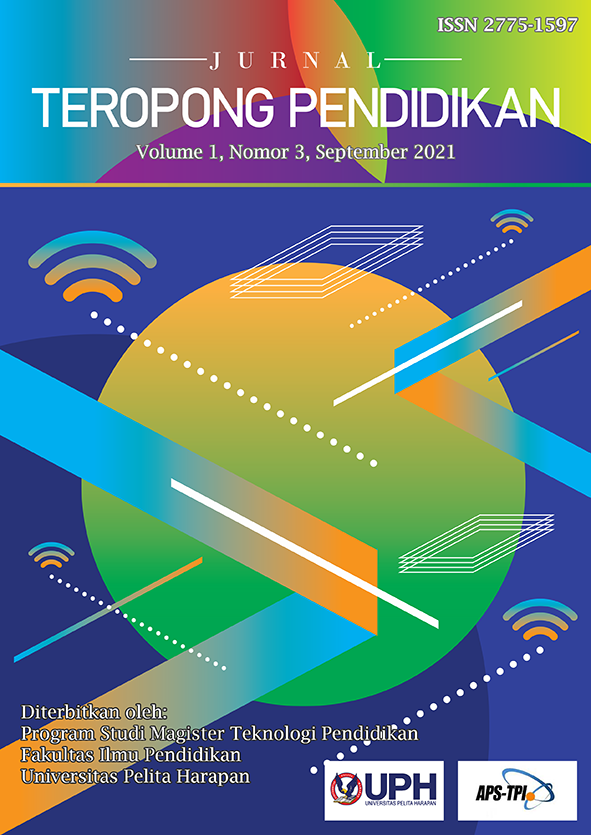Implementing Multimedia Teaching to Improve Students’ Motivation and Critical Thinking Skills Based on the Students’ Learning Styles at Mahatma Gading School
DOI:
https://doi.org/10.19166/jtp.v1i3.4189Keywords:
Multimedia, Motivation, Critical Thinking Skills, Learning StylesAbstract
This study investigated implementing multimedia teaching to improve students’ motivation and critical thinking skills based on students learning styles at Mahatma Gading School. Multimedia learning offers a significant opportunity to reach the greatest number of students and most effectively supports students with different learning styles. The study employed quantitative weak experimental of static group pre-test post-test. The respondents were 67 students from Mahatma Gading School academic year 2016. There was no control group. The data was computed using SPSS VERSION 22. Results of the pretest were observed before teaching and results of the posttest was conducted after teaching. Instruments used for data collection were in the form of test and questionnaire. The test was to measure students’ critical thinking skills and questionnaire to measure students learning styles and motivation. The researcher analyzed the data through Descriptive Statistics, and Wilcoxon Test. The data was then analyzed, which showed there was a statistically significant difference between students after implementing multimedia during the Science class. However, the result of the Wilcoxon Test on reading learners had no significant differences in students learning styles.
References
Arifah, A., & Norizan, M. (2008). Using Teaching Courseware to Enhance Classroom Interaction as A Method of Knowledge Sharing. Journal of Information Systems, Research & Practices, 1(1).
Bloom, B. S., Engelhart, M. D., Furst, E. J., Hill., W. H., & Krathwohl, D. R. (1984). Taxonomy of educational objectives. David McKay Company, Inc.
Ding, X., Liu, J. (2012). Advantages And Disadvantages of Powerpoint in Lectures to Science Students. International Journal of Education and Management Engineering, 2(9), 61-65. https://doi.org/10.5815/ijeme.2012.09.10
Dörnyei, Z., Ushioda, E. (2011). Teaching and Researching Motivation. Pearson Education Limited.
Dunn, R., & Griggs, S. A. (2000). Practical approaches to using learning styles in higher education. Bergin & Garvey.
Erdemir, N. (2011). The effect of PowerPoint and traditional lectures on students’ achievement in physics university. Journal of Turkish Science Education (TUSED), 8(3), 176-189.
Fisher, A. (2009). Critical Thinking: An Introduction. Cambridge University Press.
Fraenkel, J. P., & Wallen, N. E. (2008). How to design and evaluate research in education. McGraw-Hill Companies, Inc.
Ghaedi, G., & Jam, B. (2014). Relationships between learning style and motivation for higher education in EFL students. Theory and Practice in Language Studies, 4(6), 1232-1237. https://doi.org/10.4304/tpls.4.6.1232-1237
Gottfried, A. E. (1990). Academic Intrinsic Motivation in Young Elementary School Children. Journal of Educational Psychology, 82(3), 525-538. https://doi.org/10.1037/0022-0663.82.3.525
Hawk, T. F., Shah, A. J. (2007). Using Learning Style Instruments to Enhance Student Learning. Decision Sciences Journal of Innovative Education, 5(1), 1-19. https://doi.org/10.1111/j.1540-4609.2007.00125.x
Hepner, M. R. (2011). Developing Student Critical Thinking Skills as A Community College Adjunct Instructor. Academia. https://www.academia.edu/1144987/Developing_Student_Critical_Thinking_Skills_as_a_Community_College_Adjunct_Instructor
Lai, E. R. (2011). Motivation: A literature review. Pearson.
Leite, W. L., Svinicki, M., Shi, Y. (2009). Attempted validation of the scores of the VARK: Learning styles inventory with multitrait-multimethod confirmatory factor analysis models. Educational and Psychological Measurement, 70(2), 323-339. https://doi.org/10.1177/0013164409344507
Marcy, V. (2001). Adult learning styles: How the VARK learning style inventory can be used to improve student learning. The Journal of Physician Assistant Programs, 12(2), 117-120. http://doi.org/10.1097/01367895-200107000-00007
Mayer, R. E. (2005). Cognitive theory of multimedia learning. In R.E. Mayer (Ed.), The Cambridge handbook of multimedia learning (pp. 31-48). Cambridge University Press. https://doi.org/10.1017/CBO9780511816819.004
Moss, C. M., & Brookhart, S. M. (2012). Learning Targets: Helping Students Aim for Understanding in Today’s Lesson. Alexandria.
Noordin, S., Ahmad, W. F. W., & Hooi, Y. K. (2011). Study of effectiveness and usability of multimedia courseware integrated with 3-dimensional model as a teaching aid. International Journal of Computer Applications, 16(4), 20-27. https://doi.org/10.5120/2001-2697
Pramesti, G. (2014). Kupas tuntas penelitian dengan SPSS 22. PT Elex Media Komputindo.
Santrock, J. W. (2008). Psikologi pendidikan. Prenada Media Group.
Schunk, D. H. (1991). Self-efficacy and academic motivation. Educational Psychologist, 26, 207-231.
Sorden, S. D. (2012). The cognitive theory of multimedia learning. In Handbook of Educational Theories (pp. 1-31). Information Age Publishing.
Sugiyono. (2015). Metode penelitian kuantitatif, kualitatif, dan R&D. ALFABETA.
Surjono, H. D. (2015). The effect of multimedia and learning atyle on student achievement in online electronics course. The Turkish Online Journal of Educational Technology, 14(1), 116-122. http://tojet.net/articles/v14i1/14112.pdf
Teoh, B. S. P., & Neo, T. K. (2007). Interactive Multimedia Learning: Students’ Attitudes and Learning Impact in An Animation Course. The Turkish Online Journal of Educational Technology, 6(4).
Downloads
Published
Issue
Section
License
Authors who publish with this journal agree to the following terms:
1) Authors retain copyright and grant the journal right of first publication with the work simultaneously licensed under a Creative Commons Attribution License (CC-BY-SA 4.0) that allows others to share the work with an acknowledgement of the work's authorship and initial publication in this journal.
2) Authors are able to enter into separate, additional contractual arrangements for the non-exclusive distribution of the journal's published version of the work (e.g., post it to an institutional repository or publish it in a book), with an acknowledgement of its initial publication in this journal.
3) Authors are permitted and encouraged to post their work online (e.g., in institutional repositories or on their website). The final published PDF should be used and bibliographic details that credit the publication in this journal should be included.







